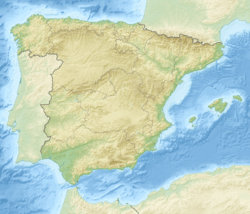Perales del Alfambra facts for kids
Quick facts for kids
Perales del Alfambra
|
|
|---|---|
| Country | Spain |
| Autonomous community | Aragon |
| Province | Teruel |
| Municipality | Perales del Alfambra |
| Area | |
| • Total | 103 km2 (40 sq mi) |
| Elevation | 1,165 m (3,822 ft) |
| Population
(2018)
|
|
| • Total | 221 |
| • Density | 2.146/km2 (5.56/sq mi) |
| Time zone | UTC+1 (CET) |
| • Summer (DST) | UTC+2 (CEST) |
Perales del Alfambra is a small town, also known as a municipality, located in the province of Teruel. This province is part of Aragon, which is one of the autonomous communities in Spain. In 2018, about 221 people lived in Perales del Alfambra.
Contents
What is a Municipality?
A municipality is like a local government area. It's a town or city, along with the surrounding land, that has its own local council. This council helps manage things like local services and rules for the people living there. Perales del Alfambra is one of these special areas in Spain.
Where is Perales del Alfambra?
Perales del Alfambra is found in the eastern part of Spain. It's located in the Aragon region, which is known for its beautiful landscapes and history. Specifically, it's in the province of Teruel. This province is in the southern part of Aragon.
Geography and Location
The town sits at a high elevation, about 1,165 meters (or 3,822 feet) above sea level. This means it's quite high up, which can affect the weather and scenery. The total area of the municipality is about 103 square kilometers (about 40 square miles). That's a good amount of space for a small community!
People and Life
With only 221 residents in 2018, Perales del Alfambra is a very small and quiet place. Life here is likely peaceful, with a strong sense of community. Small towns often have close-knit neighborhoods where everyone knows each other.
Population Details
The number of people living in a municipality can change over time. The 2018 count of 221 people gives us a snapshot of the population. This information comes from the INE, which is Spain's national statistics institute. They collect data like this to help understand how communities are growing or changing.
See also
 In Spanish: Perales del Alfambra para niños
In Spanish: Perales del Alfambra para niños


